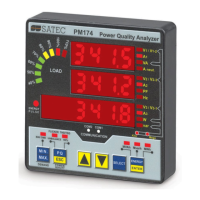
Do you have a question about the Satec PM174 and is the answer not in the manual?
| Harmonics | Up to 63rd harmonic |
|---|---|
| Current Input | 1A/5A |
| Digital Outputs | 4 or 8, depending on model |
| Communication Ports | Ethernet, RS-485, USB |
| Protocols | Modbus, DNP3, IEC 60870-5-104 |
| Accuracy | Class 0.2S |
| Display | LCD with backlight |
| Measurement Parameters | Voltage, Current, Power, Energy, Frequency, Power Factor |
| Power Supply | 85-265 V AC/100-300 V DC |
| Operating Temperature | -20°C to +70°C |
| Ingress Protection | IP54 (front panel) |
| Dimensions | 144 x 144 mm |
Describes supported communication modes: RTU, ASCII, and Modbus/TCP for the PM174.
Explains the Modbus address field for instrument addressing and broadcast mode limitations.
Lists Modbus function codes implemented in the PM174 and their corresponding actions.
Details the exception response codes sent by the instrument when errors are detected.
Explains how PM174 registers are accessed using Modbus addressing schemes like 4XXXX.
Describes data formats: 16-bit scaled integer, 32-bit long integer, and 32-bit modulo-10000.
Describes the 16-bit format for analog data and its conversion formula for readings.
Details the 32-bit format for data transmission using two adjacent 16-bit registers.
Explains the modulo-10000 format for energy counters using low and high order registers.
Covers 120 user assignable registers for mapping instrument addresses for custom access.
Describes the password protection feature for securing setups, registers, and logs.
Covers log file organization, profile data, waveform files, and file transfer procedures.
Explains how historical files are stored, data records arranged, and pointers are managed.
Details the protocol for data transfer and information services using register blocks.
Describes the TCP client for sending notifications on events or periodically to a server.
Details Modbus assignable registers, mapping, and conversion scales for device setup.
Lists 16-bit scaled analog registers and energy counters with their addresses and scales.
Lists 16-bit scaled analog registers, binary registers, and counters with detailed specifications.
Lists 32-bit analog registers, binary registers, and counters with detailed specifications.
Covers registers for minimum and maximum logged values for various parameters.
Covers registers for device control, status, event flags, and network settings.
Covers registers for device identification, factory settings, basic setup, and communication ports.
Details configuration for I/O slots, types, and parameter mappings.
Registers for controlling file transfer, response blocks, and retrieving file information.
Details the structure of daily profile data logs for billing and TOU energy/demand.
Defines Vmax, Imax, Pmax, Fmax, AImin, AImax scales and their conditions for measurements.
Specifies units like V, A, kW/kvar/kVA and their corresponding PT ratios and conditions.
Formats for timestamps and file IDs, including event, data, waveform, PQ, and fault logs.
Attributes and status bitmaps for files and records, indicating read status and errors.
IDs and masks for Billing/TOU, waveform, and profile log channels.
Format for tariff number, start hour, and start quarter for TOU settings.
Source IDs for energy registers and parameter IDs for setpoint triggers.
Values for event flags and codes for internal events like pulses and demand interval starts.
IDs for pulse inputs, relay status, and codes for static events like phase reversal.
Parameters for day of week, year, month, day, hour, minute, and second.
Values for 1-cycle and 1-sec phase/auxiliary parameters like voltage and current.
Demand values and IDs for setpoint actions such as event flags and relay operations.
IDs for event causes and their corresponding effects.
IDs for data points and event types like Setpoint, PQ, and Fault events.
Types and variations for DNP objects and assignments for Class 0 points.
Configuration options for wiring, instruments, and I/O slots.